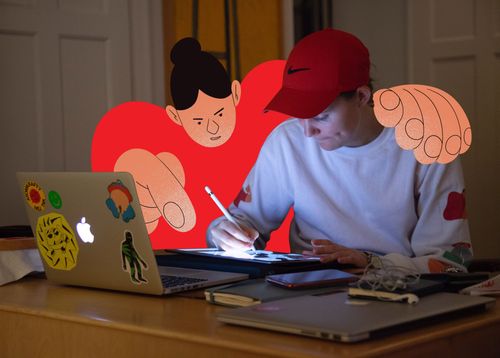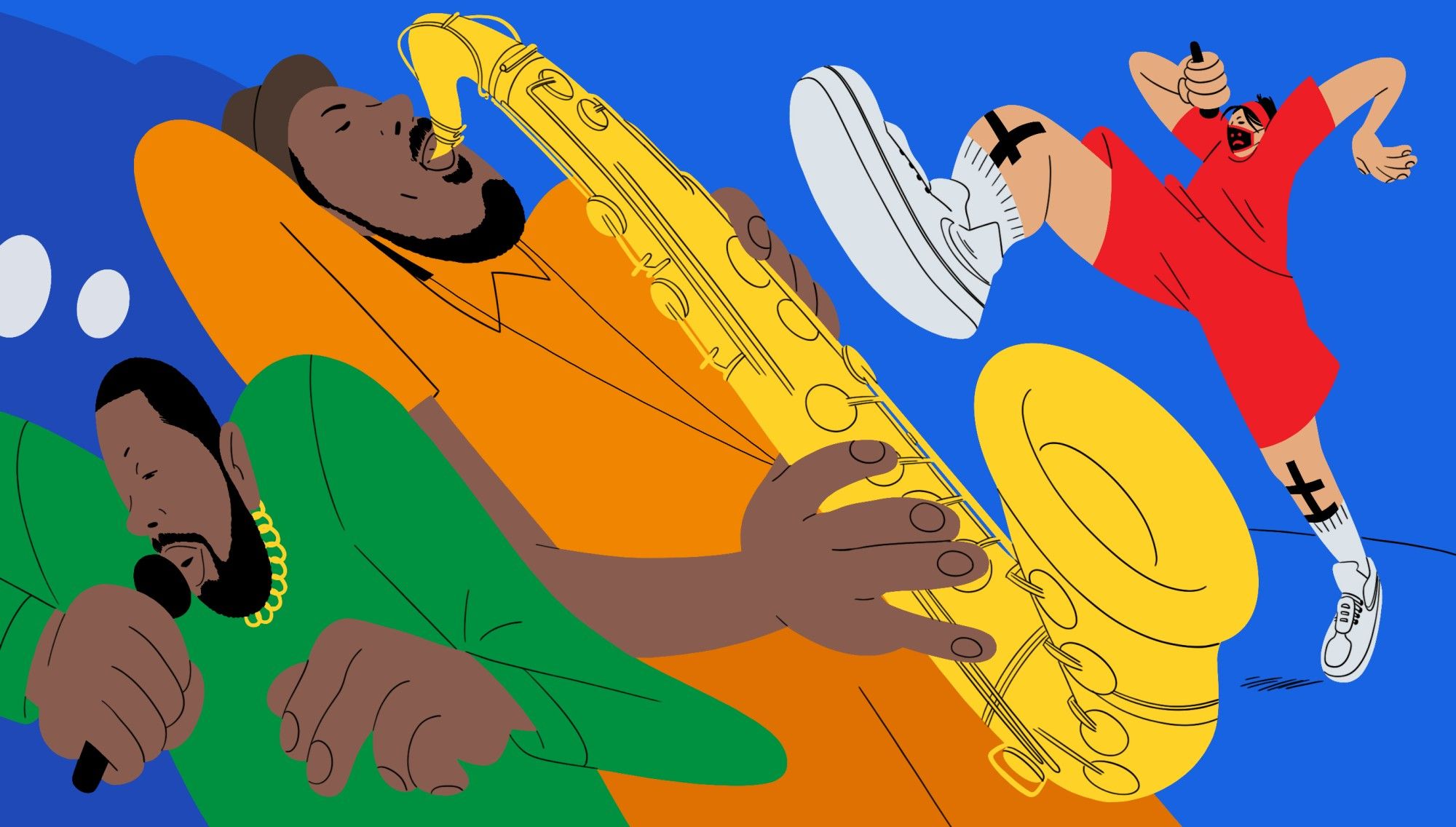
Alva Skog is an award winning Swedish illustrator who wears their heart on their sleeve. Through their unique work, Alva expresses and challenges ideas such as gender identity, perspective and inequality in clever ways that maintain broad critical and commercial appeal. Alva’s work has appeared in The Guardian and The New York Times, and they have worked with Apple, Coke and WeTransfer to name just a few.
If you don’t know Alva Skog’s work, chances are you’ve already seen it online, in a printed publication, or somewhere on the street. Their palette of strong, bold primary colors combined with perspective-bending characters are instantly engaging and recognizable. Alva’s clever visual storytelling and themes of feminism, gender ID and equality makes them a standout for a new generation of illustrators pushing the societal envelope.
Ever since graduating from Central Saint Martins University of the Arts London in 2018, Alva has been busy forging a formidable body of professional and personal work. Being in high demand, we were lucky enough to catch up with Alva before their work day began. “I like mornings, So I'm happy to be up early. I’ve been based in Stockholm in Sweden ever since the pandemic. I was in London for five years then, during the pandemic, I moved back to Sweden to be closer to my family and study. After my bachelor, I really missed that sense of community you get from studying, and I just wanted to find that again. So I’ve started studying my Master's in Visual Communication.”
Encouraged by their father, Alva’s love of drawing started at an early age. Although it wasn’t long until they surpassed their family’s skill level. “Like most people, I've been drawing since I was very little. I drew all the time. Me and my dad used to draw these ski slopes, with all these little events happening up and down the slope. He said that was him at his peak because he could do the shadows on the characters. And then after that I started doing the shadows, and he couldn't teach me anymore. Haha. I also drew a lot on manga when I was a teenager. I loved manga and still do, and that influences my work today.”

It didn’t take long after graduating for Alva’s work to get noticed, but like most creative careers it wasn’t entirely smooth sailing. After an early attempt at entering the animation industry stalled, Alva sought out an Illustration agent to help them with “navigating contracts, and fees, and licenses and stuff.” It was during this search that Jelly, their agent, reached out and a fruitful working relationship was born. Jelly and Alva are obviously a great match, with a much deeper connection that the usual artist / agent professional relationship. “They're great. They've been so supportive. And because I've been with them since I started out, it feels like I don't know what I would do without them. They're so sweet and friendly.”
“I think that was also great because people started giving me jobs quite early. Because I was signed with an agent, I seemed professional. They knew I could do the work or hit the deadline.” It wasn’t just teaming up with a good agent that helped propel Alva’s career forward. A lot of hard proactive work put in as a student also helped them stand out amongst the crowd along with the quality of their commercial work. “I had been entering a lot of competitions during my studies, and that helped make my work visible. Then the website called ‘It's Nice That’ featured my work on Women's Day, and that also gained me a lot of freelance jobs. That's how I got my first commission with The Guardian, for example.”

Another piece of the puzzle in Alva’s success story is their instantly recognizable and unique Illustration style. “It's been developing over time and still is developing a lot. I think it originates from a wish to break gender norms and create diverse representation. I'm also aware I'm very much part of a genre of Illustration. I think it's really exciting because I can see a lot of people working with diverse representation, and big body parts, strong colors, and mostly feminist messages. But I also try to keep developing and staying in tune with what I'm interested in. I think everyone's always influenced by their own interests. And right now, for me, it's a lot of feminist science fiction, for example. My favorite is Woman on the Edge of Time by Marge Piercy, so maybe my characters will go into space soon.”
Alva’s use of skewed and forced perspective positions the viewer in unusual places and situations. This give the audience a keen sense of being part of the illustration instead of just a casual observer. “The use of perspective started as a tool to empower my female characters or non-binary characters. And it's developed into a method I use a lot in my work. I love the distort (feature in Procreate). Usually, when I don't know how the perspective's going to work, I’ll distort the image and push and pull so I can experiment (with the perspective). I realized perspective could be applied to a lot of different things. It really can communicate a lot of emotion, depending on where the viewer is positioned in relationship to the character. So I really enjoy playing with that, and seeing how it can reinforce the message I'm trying to communicate.”
Like most illustrators Alva works across a diverse range of projects, but their favorite type of work is one most illustrators would normally put towards the bottom of the list. “I enjoy editorial jobs with short deadlines because I'm forced to just go with my initial ideas and not overthink, which I tend to do if I work on long projects. Also, my experience, is the process is usually very smooth. Maybe I've been lucky with the art directors I've worked with, but it's also fun to collaborate with a great art director as they see things I might not. For example, when I send roughs for an idea and then they choose one, they may suggest to add something or remove something. It's usually a very good (suggestion). They are very experienced, so I enjoy working with them.”
“If I compare an editorial project to much longer commercial ones it feels like editorials, because they're so short, aren’t going to be in the world for that long. And to me that makes them feel more free. With some commercial projects they're going to be used for a year at least. And then they want to make sure everything is just right. They're looking at a lot of details. Editorials are much more ‘Just do it,’ and then it's done. Then you get to see it out there in the world. You immediately see it in the paper, and that's such a great feeling.”
Editorial illustration often requires a strong narrative idea, something Alva is very adept at weaving into their work. Coming up with these ideas and successfully executing them visually requires a keen insight and understanding of the human condition. As Alva explains, “I think it involves me talking to people about the ideas a lot. I speak to people around me like my sister, my dad, my mom, or my classmates and friends. Then I do quick thumbnail sketches, like tiny sketches based on the ideas. And then I pick a few that I like and I draw them out. Usually, when I start to sketch them, I’ll quickly realize if they're working or not.”
The key for me is really to draw tiny, tiny drawings first. It's not about it looking good. It's more, okay, does this communicate that feeling, problem, or character?
“A lot of it is intuition, but I also know that my intuition is probably based on something. I'm constantly trying to figure out what my intuition is based on, because you always have references, or inspiration, or ideas of how to create work or communicate certain things. I also think I develop ideas by talking to people about them. If it's an editorial, I read the article several times and I underline stuff, and draw in the margins of the paper. But I think the key for me is really to draw tiny, tiny drawings first, because it's not about it looking good. It's more, okay, does this communicate that feeling, problem or character?”

Having achieved so much early on in their career, one could forgive them for struggling to find the next big challenge. But Alva’s next steps are even more ambitious than we could have imagined. “I'm actually working on a graphic novel. That's what I'm doing now in my studies as a Masters in Visual Communication, where I can get a lot of feedback and technical advice. It's very exciting. I think it's going to be black and white, and I'll also be writing it as well. Although I don’t think it's going to have a lot of text at all, what I can offer a graphic novel is communicated through images.” As a natural visual storyteller with such a dynamic art style, we couldn’t agree more.
With such drive and talent behind them, it feels like Alva can turn their artistic hand to just about anything and succeed. We look forward to seeing more of their work in the future, and can’t wait to sit down with their graphic novel and soaking in every frame.
Discover more of Alva’s energetic and enigmatic work on Instagram, Behance and at Alva's own website.